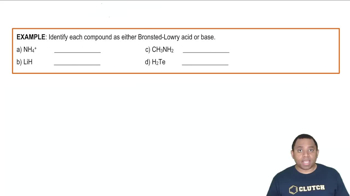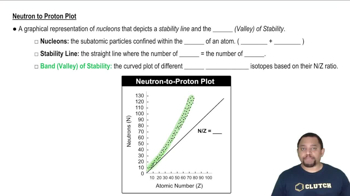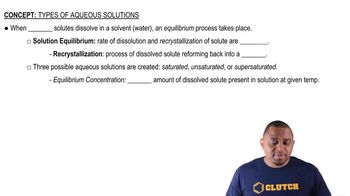Indicate whether each of the following statements is correct or incorrect. (d) K+ ion is acidic in water because it causes hydrating water molecules to become more acidic.
Ch.16 - Acid-Base Equilibria
Chapter 16, Problem 102b
Predict how each molecule or ion would act, in the Brønsted-Lowry sense, in aqueous solution by writing 'acid,' 'base,' 'both,' or 'neither' on the line provided. (b) Prozac

 Verified step by step guidance
Verified step by step guidance1
Identify the functional groups present in the molecule. In this case, the molecule contains a carboxylic acid group (-COOH) and an ester group (-COO-).
Recall that in the Brønsted-Lowry theory, an acid is a proton (H+) donor and a base is a proton acceptor.
Analyze the carboxylic acid group (-COOH). This group can donate a proton (H+) in aqueous solution, making it act as an acid.
Consider the ester group (-COO-). Esters generally do not donate or accept protons in aqueous solution, so this group does not contribute to the molecule's behavior as an acid or base.
Conclude that the molecule, due to the presence of the carboxylic acid group, will act as an acid in aqueous solution.

Verified video answer for a similar problem:
This video solution was recommended by our tutors as helpful for the problem above.
Video duration:
38sWas this helpful?
Key Concepts
Here are the essential concepts you must grasp in order to answer the question correctly.
Brønsted-Lowry Acids and Bases
The Brønsted-Lowry theory defines acids as proton donors and bases as proton acceptors. In aqueous solutions, this theory helps predict how substances will behave based on their ability to donate or accept hydrogen ions (H+). Understanding this concept is crucial for determining the acidic or basic nature of a compound, such as Prozac, in solution.
Recommended video:
Guided course

Bronsted-Lowry Acids and Bases Example
Protonation and Deprotonation
Protonation refers to the addition of a proton (H+) to a molecule, while deprotonation is the removal of a proton. These processes are fundamental in determining whether a substance acts as an acid or a base. For example, if Prozac can donate a proton from its hydroxyl (-OH) group, it may act as an acid; conversely, if it can accept a proton, it may act as a base.
Recommended video:
Guided course

Neutron-to-Proton Plot
Aqueous Solution Behavior
The behavior of molecules in aqueous solutions is influenced by their interactions with water and the solvent's properties. Water, being a polar solvent, can stabilize ions and facilitate proton transfer. Analyzing how Prozac interacts with water can provide insights into its acidic or basic behavior, as well as its solubility and reactivity in biological systems.
Recommended video:
Guided course

Types of Aqueous Solutions
Related Practice
Textbook Question
Textbook Question
A solution is made by adding 0.300 g Ca1OH221s2, 50.0 mL of 1.40 M HNO3, and enough water to make a final volume of 75.0 mL. Assuming that all of the solid dissolves, what is the pH of the final solution?
Textbook Question
Which, if any, of the following statements are true? (a) The stronger the base, the smaller the pKb. (b) The stronger the base, the larger the pKb. (c) The stronger the base, the smaller the Kb. (d) The stronger the base, the larger the Kb. (e) The stronger the base, the smaller the pKa of its conjugate acid. (f) The stronger the base, the larger the pKa of its conjugate acid.
Textbook Question
Calculate the pH of a solution made by adding 2.50 g of lithium oxide 1Li2O2 to enough water to make 1.500 L of solution.
